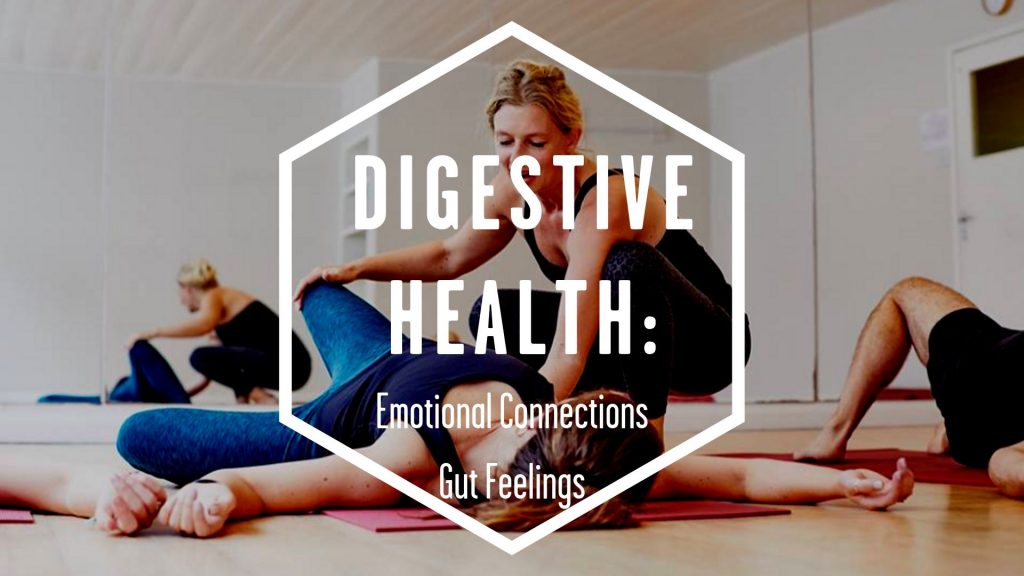
In the last of her five part series on digestive health, Charlotte Watts explores how the belly provides a home for gut feelings as well as housing the physical function of digestion.
Gut feelings and the chakras
As we have explored in previous articles in this series, health in the gut is not just as simple as the basic functions of digestive processes. This is a rich and responsive landscape, it constantly reflects and expresses our sense of safety and boundaries. This area is informed by our past stories in relation to where we find ourselves in the current moment. Our gut feelings are important.
Many spiritual and philosophical systems – such as the hara in Daoism – see our bellies as the place where our true essence resides, and where we can tune into these deep inner voices. If we can cultivate the awareness to discern when we might be reacting to stress or trauma there and sift beneath to connect with our more intuitive ‘essence nature’ there, we have the opportunity to move, act and communicate from our true needs; authenticity.
Gaining insights through listening to our gut feelings
This union is the foundation for trust and safety felt deep into the gut; where we not only move from a more easeful place, but also the whole mind-body state in which digestion functions as designed. In this article we use the framework of the chakras to help provide insight into how our mind-body development can be understood from the gut.
Traditional to modern chakra theory
The Tantric scholar Christopher Wallis described the chakras (or cakra in the original Sanskrit) as “focal points for meditation within the human body, visualised as structures of energy resembling discs or flowers at those points where a number of nāḍīs or meridians converge.” This original use has been changed in the last century or so. This change is influenced by the more psychologically-based work of those such as Carl Jung, and the Theosophy movement.
A psychological model for understanding gut feelings
This has resulted in the ‘New Age’ rainbow coloured seven-chakra model we most often see now. This is where specific emotions or psychological states are assigned to each. Many argue this is at odds with the original meaning. This continues to be useful for many as it fits into modern, Western culture brought up on psychological models.
The three chakras and the digestive tract
In this article we explore the first three chakras as they relate to the digestive tract. The chakras chart our journey from grounding to movement and coming into self and are the centres responsible for our gut feelings.
Muladhara – the Root Chakra
Traditionally this is the chakra of the earth element with the word mula meaning ’root’ and adhara ‘support’ or ‘base’. It is situated in the pelvic floor, base of spine and first three vertebrae. The Muladhara is the foundation of the energy body. This area is also the base of physicality; sitting, standing and walking.
Modern understanding of Muladhara
Modern usage illustrates it as a red colour and with the qualities of stability; from where we might feel grounded, loyal, connected to family, steady and safe. It is attributed to our development from the womb to the first year of life in the world. This is challenged by fear throughout our lives as a response to our needs for survival and self-preservation through instinct.
Our right to be here and to exist can be disturbed when the first chakra is unable to develop. Birth trauma and separation or rejection from the mother can impair first chakra development. Many suffering stress, trauma and related symptoms like IBS feel agitated, disassociated and disconnected from the physical body. In this situation the digestive system takes the strain. The sense of smell originates here as the first prompt to digestion.
All of our conscious and unconscious decisions have a basis of approach/withdraw (safe/unsafe) that come from a visceral trust/mistrust that we respond to from gut feelings, laid down as our muladhara chakra forms. We can respond to old triggers from here when we feel unsafe.
Root chakra practice
Belly Circling: a moving meditation that soothes and catches up the mind’s attention, to allow focus into the belly, beneath a busy mind – fostering safety back down to the ground. It also loosens fascia deep into the abdomen, organs and hips to support digestion and elimination.
From any seated position, from a lifted spine circle the whole torso. Keep the shoulders uninvolved and chin drawing lightly into the throat, so that the movement comes from the belly – front brain, jaw and eyes soft. It may feel organic to inhale as you move round and back, exhale as you sweep forward.
Change direction when it feels right and fully experience the difference in flow, counter to the way you picked first. This can also be practiced sitting on a chair with thighs 90 degrees apart and feet planted. Place the heels under knees for uplift through the front spine.
Svadhisthana – the Sacral Chakra
The second chakra traditionally relates to the water element, where the sacral (sacred) chakra, translates as ‘one’s own abode’ or ‘the dwelling place of the self’. It is located about two finger-widths above the Muladhara, at the last bone in the spinal cord, the coccyx and from the front, just below the navel.
Water relates to procreation, a sense of taste and creativity. The modern colour assignation is orange. This chakra is attributed with the ability to flow, be adaptable and the quality of patience.
We are said to develop into these aspects from 6 months to 2 years and grow into between ages 8 and 14, when our movement, coordination and expression are forming according to the world around us. Our emotions, creativity and unconscious feelings and actions are stored here and come out from how we move from the belly out to the edges of our bodies.
Moving from first to second chakra during the transformative period of 6 months to 2 years, we shift from the stasis of earth to the fluidity of water, feeling the motivation of desire and pleasure, embracing the creativity of change. We explore the realm of ‘other’ outside of ourselves.
Our ability to let go is bound to how we express sensuality and pleasure. This includes bowel elimination and releasing tension held in the abdomen that can impair digestive function. It can therefore be seen that freedom of movement at the sacrum and belly are bound up in digestive processes.
Sacral chakra practice
Reaching belly to hands: ‘Reach’ motions mimic those we naturally make to acquire something we want. Mirroring the relationship between desire and creativity that starts at the second chakra. Movement follows the direction of gaze and desire; a motivation to find organisation through the path of least resistance, with most ease and grace from the sacrum out.
Starting from a ‘z-shape’ seated position, with left leg bent inwards and right bent outwards, lean towards the left, using the right arm to support yourself. Lift the spine up through the shoulders, to not just hang off the right shoulder. Take the right arm out to the side and focus your gaze on it, spending a few moments here to fully place your mind into your hand. Then sweep the arm down and past your body to create full circles, reaching up and over, back through the starting point.
As you circle, keep a steady focus with your eyes (drishti in yoga) on the hand for movement out from the navel, allowing the motion to reach from the belly, through to the chest, shoulders, neck and head with most fluidity, feeling it through the hips. Change to the other side, taking your time to feel difference and therefore presence connected down to the belly.
Manipura – the Solar Plexus Chakra
This is the associated with the fire element in tantric and yoga traditions. The Solar Plexus chakra is just above the navel and reaches up into the breastbone. This chakra signifies personal power and sense of self. Translations for Manipura include ‘lustrous gem’ or ‘city of jewels’. This is our seat of potential transformation where the fiery energy agni, governs digestion, metabolism and energy.
Modern understanding of Manipura
More modern usage suggests this as a yellow colour and it also relates to the liver, gall bladder, solar plexus, adrenals and pancreas. It equates with qualities of change, ego and capability. Fire burning upwards (the first two chakras are downwards moving) signifies our will and get-up-and-go.
The developmental stage is 18 months to 3-4 years, with full discovery at ages 14 to 21 years. This is time of honing our individuality, which can take courage and power, permission to move as we feel – “I” – and gaining a healthy sense of autonomy.
Seen as the seat of digestion, agni processes all we receive: food, thoughts and emotions. Anything left partially metabolised can create stagnation. In the Ayurvedic system this is called ama and refers to what is incompletely transformed and as a result is toxic. As a result we may feel disease (digestive and other) if we have not digested early experiences or other situations in life. We commonly feel stress, tension and fear in the solar plexus region and this affects our digestion. By listening to our gut feelings we can ascertain how to improve our health.
Early neglect, lack of attunement, too little autonomy and shame can create depletion in the third chakra. This leads to lethargy and lacklustre energy (tamas). This is turn can show up in fatigue conditions and depressive, demotivated, withdrawn, fearful and overly quiet states.
Personal power at Manipura means not judging ourselves on what we think or do. Rather it means there is a healthy separation between our thoughts or actions and us. This is a mindful dis-identification that can free us from the absolutist associations that if we think or do something ‘bad’ that we are bad.
Solar Plexus chakra practice
Circling a ball: this loosening movement builds on the first chakra support of the feet and legs, up into the second chakra expression of movement from the belly, to stand up into ‘self’ at the solar plexus. It combines rotation, diaphragm freeing and shifting the centre of gravity to prepare beautifully for other standing postures or movements.
Hold an imaginary football in front of your solar plexus. Feel this space whilst you settle into your feet (hip-width apart) and feel the ground up from the insteps, through the inner legs, up the spine to the chest.
Then take the ball to about eye height or higher, so your neck feels comfortable. Hold the arms in a circle to keep the soft ventral space of the inner arms opening out from and around the solar plexus. Keep your focus on the ball, rotate it fully in front of your body. Bend your knees as you reach it right down past your inner legs.
About Charlotte Watts:

Charlotte Watts is a Senior Yoga Teacher. Charlotte loves explorative, compassionate and somatic yoga practices. She infuses her practice with Qi Gong and Feldenkrais. She teaches classes in Brighton and London. Charlotte also teaches workshops and retreats in the UK and abroad. Charlotte teaches modules for Teaching Yoga for for Digestive Health for Yogacampus. She also teaches on the Yoga Therapy course for The Minded Institute.
Charlotte is an author with many published books, including Yoga Therapy for Digestive Health (Singing Dragon 2018). She is an award-winning nutritionist practising since 2000. Charlotte specialises in stress-related and fatigue conditions and burnout, and digestive issues.





Thanks very much for for this article. The first tranche of information I’ve ever properly read about Chakras…. Very well written and accessible to a western mind 🙂